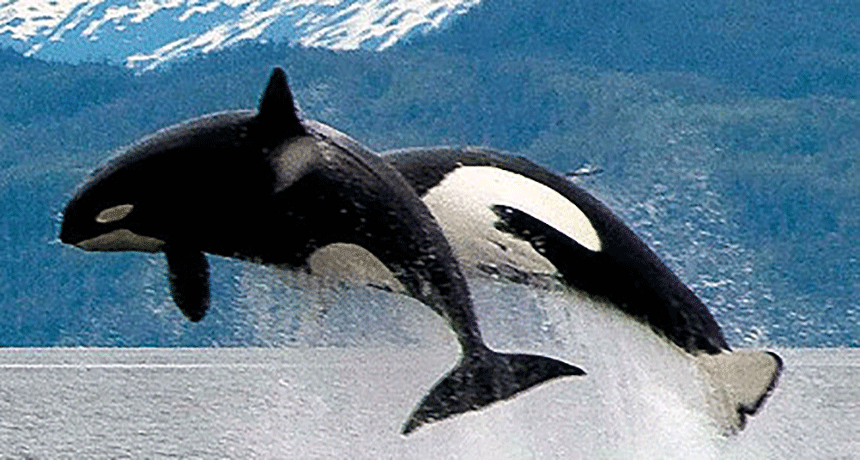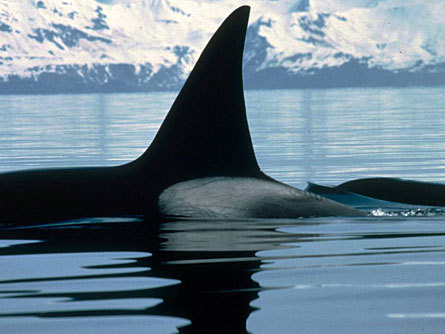A grim future for some killer whales
An oil spill off the U.S. coast 20 years ago still threatens marine life

This 25-year-old AT-1 male (foreground) isn't as physically developed as he should be, says marine biologist Craig Matkin. Behind junior: mom.
Cathy Hart Photography
Share this:
- Share via email (Opens in new window) Email
- Click to share on Facebook (Opens in new window) Facebook
- Click to share on X (Opens in new window) X
- Click to share on Pinterest (Opens in new window) Pinterest
- Click to share on Reddit (Opens in new window) Reddit
- Share to Google Classroom (Opens in new window) Google Classroom
- Click to print (Opens in new window) Print
In 1989, an oil tanker called the Exxon Valdez struck an underwater reef in Prince William Sound, a large body of water in southern Alaska. The ship dumped about 11 million gallons of crude oil into the freezing water, creating the largest spill in U.S. history — and a disaster for animals that lived in or near the water.
Now, 20 years later, the area still has not fully recovered. At the time of the spill, two groups of orcas, or killer whales, were swimming in the area. One of these groups of whales appears to be headed for extinction, and the other is recovering more slowly than scientists had predicted.
The first group, called AT-1, wasn’t large to begin with: When the spill happened, the group had 22 whales. Nine of these whales died during the spill, and since then, no baby whales have been born in the group. The older males — who can live to be 60 — have been dying off. Now, only seven whales remain.
These orcas may look like and live in the same areas as other killer whales, but orcas in the AT-1 group are genetically different and communicate with a different set of sounds. They are transient orcas, which have larger home ranges than the other kind of killer whales, called resident orcas. Transient orcas eat mammals, such as harbor seals, sea lions, porpoises and other whales; resident orcas eat fish. These two types of killer whales don’t breed with each other.
Lingering effects from the oil spill are not the only threats to orcas. The whales are swimming in polluted waters, and scientists have found these pollutants in the whales’ blubber (or fat). These toxic substances may keep the whales from reproducing successfully. The pollution probably originated in plumes of air that wafted across the Pacific from China and Southeast Asia, says Craig Matkin, a marine mammal biologist who studies the whales.
“I don’t want to make it sound like the oil spill is solely responsible for [this group of whales’] decline,” Matkin says. “It just exacerbated an already bad situation.”
 |
|
This male from the AT-1 population of transient orcas exhibits a curiously stunted, or small, dorsal fin.
|
| Matkin/NGOS |
The other group of endangered whales eats fish and squid. These are resident killer whales, and their group is called AB. After the spill, 13 whales in this group died. Scientists predicted the population would recover — that is, return to its original size — within 12 years. But they were wrong. The whales that died were mostly females and juveniles. Now, 20 years later, scientists think the AB group of whales will not recover for another 10 years.
The oil spill also broke up the family structure of the whales. Groups of orcas live in matriarchal communities, where a female acts as the head of the family. The matriarch of the AB group apparently died in the oil spill, and afterward many whales left to join a different group.
When the AB group does eventually recover, it won’t be the same. And the AT-1 group may become extinct. Other scientists are finding that certain other major species affected by the oil-spill — like otters, clams, herring and certain birds — have also failed to fully recover. And in many cases, they’re surprised about why, 20 years after the spill, so many effects of the Exxon Valdez disaster still persist.
Power Words: (from the Yahoo! Kids Dictionary)
Orca: A black and white predatory whale (Orcinus orca) that feeds on large fish, squid and sometimes dolphins and seals. Also called killer whales.
Extinct: No longer existing or living.
Reef: A strip or ridge of rocks, sand or coral that rises to or near the surface of a body of water.
Genetics: The branch of biology that deals with heredity, or the passing of biological traits from parents to their offspring through genes.
Mammal: Any of various warm-blooded vertebrate animals of the class Mammalia, including humans. Mammals are characterized by a covering of hair on the skin and, in females, milk-producing mammary glands for nourishing the young.







